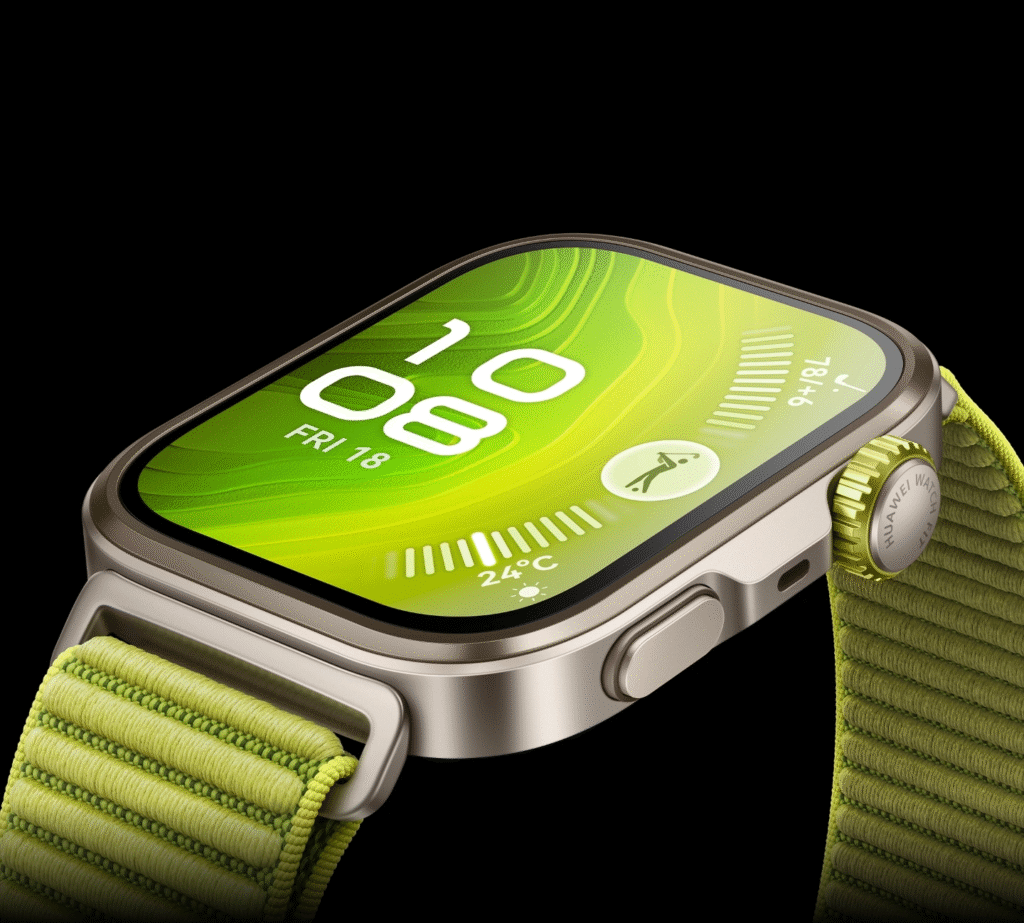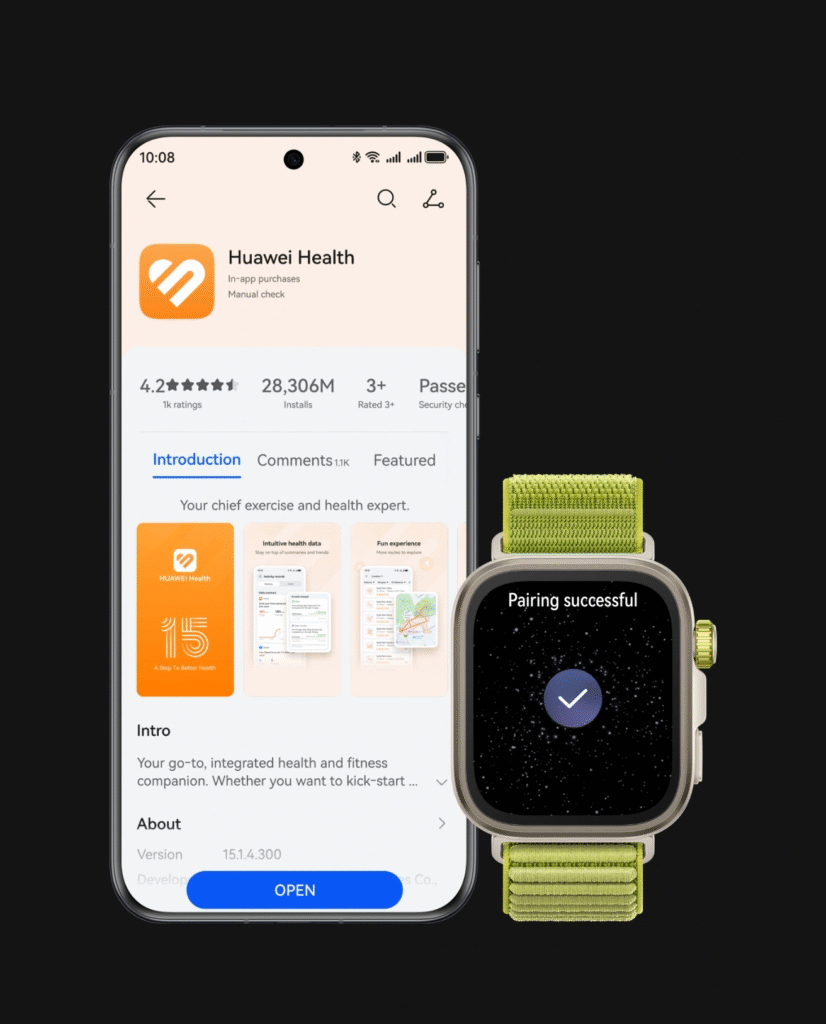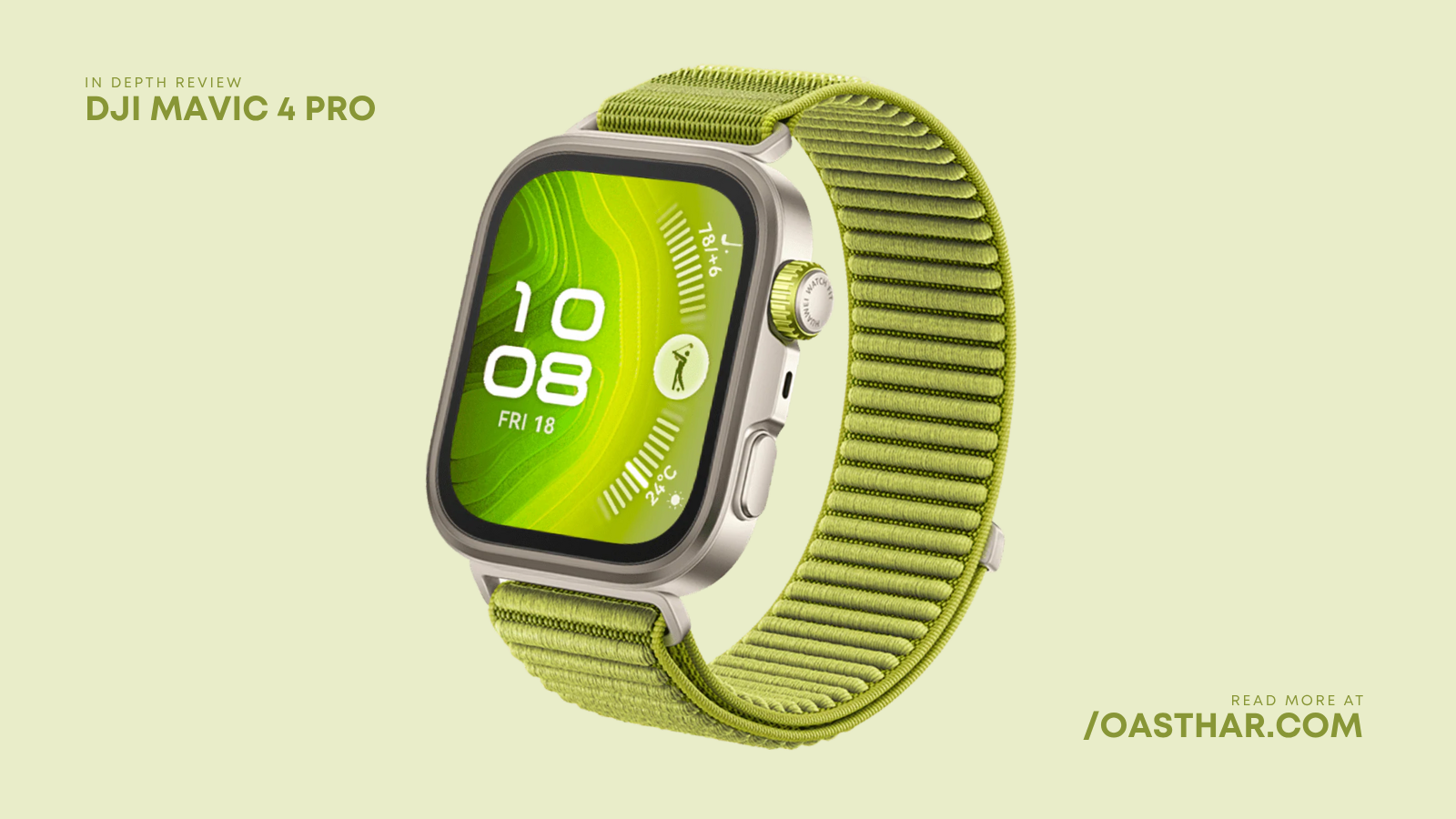Ever wondered if the Huawei Watch Fit 4 Pro can truly rival flagship smartwatches while delivering seven-day battery life, ECG monitoring, and an ultra-bright AMOLED display—all without costing a fortune?
In this hands-on review, I’ll break down every detail, from build quality to advanced health metrics, so you know exactly what you’re getting before you buy.
Related: Xiaomi Watch S4 Review
Design & Build Quality
When I first slipped on the Huawei Watch Fit 4 Pro, its combination of titanium alloy bezel, sapphire glass, and aerospace-grade aluminum frame immediately set it apart.
At just 30.4 g, it’s astonishingly lightweight—so much so that I often forgot I was wearing it during evening stretches. Yet despite the feather-light feel, there’s zero flex or creaking when I twist my wrist; this thing feels indestructible.
The case measures 44.5 × 40 × 9.3 mm, striking an excellent balance between screen real estate and wrist comfort. On my medium-sized wrist, it sat flush and hugged the contours perfectly.
I’ve tested many watches where the sensor array protrudes, causing pressure points. Here, the ceramic backplate is nearly flush, so long workouts and sleep tracking sessions remained irritation-free.
Strap options include a smooth fluoroelastomer band and a breathable woven nylon alternative—both sporting Huawei’s quick-release pins.
Swapping bands took under five seconds, and I even popped on a 20 mm third-party leather strap for a dressier look: it locked in securely with no wiggling. The finish on the lugs is neatly chamfered, minimizing snags on shirt cuffs and gym attire alike.
Aesthetically, Huawei takes cues from the rectangular Apple Watch form factor but injects its own flair with slightly sharper edges and a slimmer profile.
The digital crown offers satisfying tactile feedback when scrolled, and the side button sits just far enough that I didn’t trigger workouts by accident. Overall, the Watch Fit 4 Pro nails the trifecta of durability, comfort, and style—proof that you don’t need to sacrifice premium materials at this price point.
Display & Screen Quality

With a 1.82-inch AMOLED panel at 480 × 408 pixels (~350 ppi), the Watch Fit 4 Pro’s display is among the sharpest in its class.
What really blew me away was the advertised 3,000 nits of peak brightness—on sunny midday runs, I could read notifications and workout stats without shading the screen with my hand.
Touch response is snappy and accurate, whether I’m swiping through menus or tapping the mini QWERTY keyboard to reply to a message.
Huawei’s always-on display (AOD) dimmed just enough to save battery yet remained legible at a glance. Colors pop without feeling oversaturated: deep blacks thanks to true OLED contrast, vivid reds on heart-rate graphs, and crisp whites on text.

The Watch Fit 4 Pro includes dozens of preloaded watch faces—some animated, some minimal—but you can also create your own via the Huawei Health app.
Custom faces allow you to choose complications like step count, weather, and battery percentage, then place them anywhere on the screen. Even under direct sunlight, complications remain clear.
My only minor gripe: the top and bottom bezels measure around 3.5 mm, making them noticeable against lighter watch faces. A dark-themed face easily masks them, but if you love pastel or white faces, you might spot the borders.
Thankfully, Huawei’s face store includes many dark designs for seamless integration. Overall, this is one of the brightest, most responsive smartwatch displays I’ve ever tested—perfect for workouts, office wear, and everything in between.
Performance & Software Experience
Under the hood, Huawei’s proprietary HarmonyOS 5.1 powers the Watch Fit 4 Pro, and in daily use it feels smooth as butter. While Huawei doesn’t disclose the exact chipset or RAM figures, I never encountered stutters scrolling menus, jumping back to notifications, or launching workout modes. Apps open within a second or two, and switching between notifications and music controls is seamless.
I primarily paired it with Android, but iOS support via the Huawei Health app is nearly identical—minus a handful of Android-only integrations.
Syncing with the Health app happens automatically over Bluetooth 5.2; initial pairing took just 20 seconds after scanning the on-watch QR code. Once connected, incoming call and message alerts popped up instantly on my wrist.
The digital crown offers tactile scrolling through lists and notifications, while the programmable side button defaults to opening workouts—but you can remap it to apps like Alipay or the stopwatch.
Third-party app support remains limited: there’s no Spotify or Google Maps standalone app, though Huawei’s built-in Petal Maps can mirror turn-by-turn directions during workout sessions. You can preload offline maps via your phone, then access them in “Outdoor Run” or “Hike” modes.
A minor annoyance: after a firmware update, I noticed occasional sync delays when switching watch faces, requiring a manual refresh in the app.
It happened twice over my three-week test, and a quick reboot fixed it. Beyond that, the OS is polished, intuitive, and, in my opinion, one of the best non-Apple smartwatch experiences you can get outside the Wear OS ecosystem.
Health & Fitness Features
Huawei packs the Fit 4 Pro with an arsenal of advanced sensors—far beyond simple step counting. Here’s how they break down:
Workout Modes & GPS
With 100+ workout modes, from standard running and cycling to niche activities like ballet and freediving, there’s almost nothing you can’t track.
The dual-band GNSS (GPS/GLONASS/BeiDou/Galileo/QZSS) locks onto satellites in under 10 seconds outdoors, and on my 10 km trail run it stayed accurate within 5 m when compared to a dedicated Garmin Edge unit. Real-time pacing, elevation graphs, and offline color maps keep your route visible right on your wrist—no phone required.
Sleep Tracking & Recovery
Huawei’s TruSleep 4.0 analytics break down your night into deep, light, REM, and awake phases, then spit out a sleep score with personalized tips.
The new Sleep Breathing Awareness algorithm flagged occasional breathing irregularities—while not a medical diagnosis, it’s great for spotting trends before discussing them with a professional. I also tested the skin-temperature sensor overnight: it recorded minor fluctuations that correlated with my restless periods.
ECG, SpO₂ & Advanced Monitoring
What sets the Pro apart is its medical-grade ECG capability—usually found only on flagship smartwatches. A 30-second reading generates a PDF report you can export for your doctor. Continuous SpO₂ monitoring proved highly accurate versus a fingertip oximeter, and the arterial stiffness index gave me insights into my cardiovascular health after intense workouts. All these readings are powered by the HUAWEI TruSeen optical heart-rate sensor, which I found impressively precise, even during rapid-fire HIIT sessions.
In short, the Watch Fit 4 Pro isn’t just another activity tracker—it’s a comprehensive health companion, packing flagship-level sensors into a midrange price bracket.
Connectivity, Extra Features & Battery Life
Huawei doesn’t skimp on extras: the Fit 4 Pro includes Bluetooth 5.2, NFC for contactless payments, and 1.5 GB of onboard music storage (about 300 MP3 tracks).
Pair it with your Bluetooth earbuds to leave your phone behind on runs, then control playback from your wrist. NFC support varies by region, but in Europe and Asia it integrates seamlessly with major banks for on-the-go payments.
Voice calls over Bluetooth are surprisingly clear—callers commented I sounded “just like I was holding my phone.” There’s no built-in voice assistant like Siri or Google Assistant, but Huawei’s voice memo app and microphone let you record quick reminders hands-free.
Petal Maps integration provides turn-by-turn navigation during outdoor workouts if you preload routes in the Health app.
Battery life is where this watch truly shines. Huawei claims up to 7 days of typical use and 10 days in Battery Saver mode. In my real-world test—two 30-minute GPS sessions, AOD enabled, heart-rate and SpO₂ always on—I consistently hit six days before dipping below 20 percent.
Switching off AOD and limiting continuous SpO₂ bumped me to a solid seven days. When you do need a top-up, the bundled wireless charger refills from zero to 100 percent in about 60 minutes—far faster than most competitors.
User Experience & Practicality
From boardroom meetings to weekend hikes, the Fit 4 Pro has been my 24/7 companion. Notification management is granular: I only get pings from messaging apps and calendar invites, keeping interruptions to a minimum.
The haptic motor delivers firm, yet discreet, vibrations—I never missed a reminder, even in loud gyms, but sleep tracking wasn’t disturbed by nighttime nudges.
Huawei’s quick-reply keyboard feels surprisingly usable for short messages; longer texts I send via phone.
The fluoroelastomer strap handled sweat without odor, while the woven band stayed cool on hot days. I did notice a slight data-sync pause when switching between my phone and tablet, but it never disrupted real-time workout tracking.
Gym scanners and NFC-enabled turnstiles accepted the watch’s payment token flawlessly—no more fumbling for wallets.
The watch also survived splashes, showers, and a couple of impromptu pool swims without missing a beat (it’s rated 5 ATM). Overall, the user experience is intuitive, polished, and practical for both fitness enthusiasts and everyday users.
Pricing & Value for Money
Huawei Watch Fit 4 Pro launches at $249 (approximately $316) across Europe, Asia, and the Middle East. Compare that to:
- Apple Watch SE (2024) – $336 (36-hour battery, ECG only on higher models)
- Samsung Galaxy Watch FE – $309 (2-day battery, no ECG)
- Withings ScanWatch 2 – $377 (30-day analog battery, limited GPS)
Given the titanium bezel, sapphire glass, seven-day battery, ECG, SpO₂, skin-temp sensor, and 100+ workout modes, Huawei undercuts most rivals while matching or exceeding their feature set.
For fitness buffs seeking clinical-grade health metrics, coupled with a bright screen and week-long runtime, this watch is a steal. Even casual users benefit from long battery life and hassle-free payments. In my view, it’s the best value-for-money smartwatch in 2025’s midrange segment.
Final Verdict & Pros & Cons Summary
After a month of nonstop testing, the Huawei Watch Fit 4 Pro has cemented itself as my go-to midrange smartwatch. Its flagship-level build, comprehensive health tracking suite, and battery life measured in days—not hours—make it stand out in a crowded market.
Pros:
- Up to 7 days of real-world battery life
- ECG, SpO₂, arterial stiffness, skin-temp sensors
- 1.82″ AMOLED at 3,000 nits peak brightness
- Titanium bezel & sapphire glass durability
- 100+ workout modes with dual-band GNSS & offline maps
- Wireless charging in ~60 minutes
Cons:
- Limited third-party app ecosystem (no Spotify, no voice assistant)
- Occasional sync delays after firmware updates
- Slightly thick bezels on light-colored watch faces
- NFC support depends on region & bank
If you prioritize battery life and advanced health monitoring over app variety, the Watch Fit 4 Pro is the clear winner in its class. It delivers flagship features at a fraction of the cost, making it my top recommendation for 2025.
Related: OnePlus Watch 3 Review




